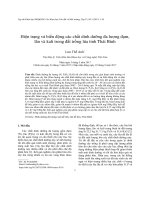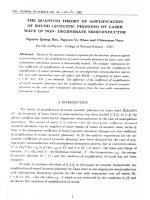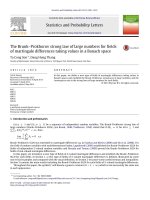DSpace at VNU: The Relativistic Operator Quantization of Linearized Gravity Theory
Bạn đang xem bản rút gọn của tài liệu. Xem và tải ngay bản đầy đủ của tài liệu tại đây (1.96 MB, 3 trang )
VNU. J OU RN AL O F SCIENCE, Nat. Sci,, t.x v , n ° 2 - 1999
T H E RELATIVISTIC O PE R A T O R Q U A NTIZATIO N
OF LINEARIZED G R A V ITY TH EO RY
Nguyen Suan Han
Fiicnlty of Physics - College of Na.tural Sciences - VNU
1. Quantization of the linearized gravity gives an evidence about the importance of
physically motivated assumptions for the small metric - tensor components to be neglected,
which concerns with the existence of gravitational waves in the conventional understanding
of this problem.
Giavitational wave in gxavity theory are considered as quantum excitations of weak
classical fields. In this context, the construction of a gravity quantization scheme which
is adequate to the problem of elementary excitations is important. From such a point
of view the relativist,ic operator quantization method(*) with an explicit, solution of the
constraint equation [1, 2] is distinguished among the large variety of gravitational field
quantization approaches [3, 4 .
2. Consider the action for Einstein gravity theory
S= Ịự ^d^x.
(1 )
Where R is scalar curvature g = d e t ự ^
9 ụ.v{^)-
is the inverse of the tensor
In a weak field approximation
hụ,Vi
I-
(2 )
The variables h^,^{:r) discribe the linearzed gravitational field, and fj.L' is the Minkovski
metric tensoi with diagonal ( 1 , - 1 , - 1 , - 1 ) . The Lagrangian then takes the form (up to
0 { h ^ ) - tprmc;)
i/a
(3)
=
-2 d o h o ,{d kh kt -
d ,h .jj)-d k h o ,{ở ,h o i, -
dkho,).
This action contains constraints which intioducp a transverse structure
ốh 00
= 0^
d ,A Ĩ
= 0,
A Ị
=
drhị,,
-
(4
with the corresponding oquatioii of motion
= 0 => d o A
l = dr { d , h o , -
d,h o r).
(5)
ỗ h 0?
(*)
For brevity this m e t h o d can be called "mini mai ". bec au s e it is concerned with t h e q ua nt i z at i o n only
of minimal n u m b e r of physical degrees of freedom remaining after t h e explicit solution of a c on s tr a in t on the
classical level tl].[2]
Oft
T h e
R e l a ti v i s H c
O il
O p e r a t o r
Q u a n t i z a t i o n
tlir so h itiííii ( j f t l u ' coDistraiiits (4)
= l^d>‘h , ,A ( ih
2
A(//>
ỈÌĨÌỊ
27
o f,
(5 ), L agraiiK iaij (3) ro a d s
hn.)fLhi,n,
d , d i ,
A ^kĩìì
— í^íA-^/rỉí
(6)
dk dm
íl
*
wlicic iii(‘ proji 'cti on o p e r a t o r A ị i k ị l ì ì i ) r a n be^ co nsidered as defining th e d i s t a n c e in th e
SỊ)HC(' of (l\ jiHinical Hold ỉì,ị,- o rb it s with m s p e c t t o infinitesimal gauge transforrnatioiis
ỉhk
—
ỉ>ik +
+
ỡklh^
(7)
F r o m L a ^ i a n g i a n (6). caiioniral nioiueiita is o b ta in e d
Prs ^ Ẩ \{ r s \h ìì) d o h ir n { -r )
(8)
which ot)('\- ĩh(’ foUowin^ {■oiiiniutation relationy
(■/')./>r.s(//)] = M ỉ w \ r s ) { . r ) ố ( . r ~ y ) .
Tli('
- I i i o n i n i t u m te n so r is o b t a i n e d t o he svinnietric aiiid
- ịt)^,u^"ha■^i^^^ụ'7ì)^alll,n■
'-/'/u.* =
(9)
invariant
(10)
It <1(K'S not r('Ị)r(\soní a full (iorivative a n d ^iv(\s riso to a set of P o i n c a r é - gxoup
^(MK'raturs in wliicli boos t ^ e n e i a t o i s induce a nd a d d iti on a l gauge t r a n s f o n n a t i o n of th e
{.rod, -
.v,do)Mr.s\lin)}iir„{.r) + { ở r ~ P i s +
(11)
riiis additional ^ a iig í'traiisfonnatioii leads to a time - axis rotation that ensure the
ielativisti( ccA'ariaiKT of thi s inanifostly non-covariaiit q u a n ti z a ti o n proce dure,
i n tl i i r. : : p a r c r n n h o íU'fii ìí '(Ị a n
e : , A { i . k \ h n ) e l , = 0^” ^
(12)
a , b = l , 2.
wIk'io /*/, is tlu' i h r v v - (liuHuisional projection o p e r a t o r
P,A =
p, k = e f 4 ,
e‘^ P , , 4 -
(13)
a, 13= 1,2.
T h u s . th(‘ re levant p o la ri z a t io n s are found to be
- eỊeị, and eị. = e ịe ị,
(14)
aiul for tli(' iiu lr ppi uk' ut physical variables
^ e^,,A{ik\lm)hu^_^
the free two - component scalar field Lagrangiaii is obtained
L'2) =
(15)
(16)
Ngtiyen Suan Hail
28
hoiuT. plaiK' wav(’s an' pi'('S('iit ill tli(' rxcitalioii ^pi'ctniiii of tlir liiU'Hi izf‘
Tlit‘i('foro. ininiinal qiiaiitizatiun of weak ^lavitaiional fii'lds irpixKluci's th(' ladiatioiial -
K'sults To^(‘tli(‘r w it h co rrespoiuliiig atlditiunal c o i u l i t i o n s wliicli ai( ‘ in fact
geii(Maĩ(Ml hv tli(‘ (HỊuaíious o f m o t i o n for thí' Iiond yna in iral Helds //(,() a n d //{),.
For tlie oiii;inal thf'ory (1) without any additional assumptions alìoiiĩ the holds
Iiiiniiiial q u a n t i z a t i o i i c o n s i s t s o f e’xc’l ucl ing noiipliVvSical
o f fn'iHloni i l i r o u g h tlio
exac t sohitions of tlieii ('qnations of motion (constiaints). Howovoi. tho coincidf'nce of the
linearized expansion of the action obtainod with the one rousidered above (in the naivf'
linearization S(‘lionio) is by no means obvious, the reason l)riug tho (listin^uishod rolo of
the Newton coinpoiH'iit (/00. Thus. avSyuniiiig that coiulitioii (2) coiu-orns only dynamical
fields
wo aro foirod to ronsidor also components hio as small vai ial)l('s hocause of thí'
constlaints. hut no rrstiiction is iinpospd on the XfnvtonCoiiipoiioiit //()(). In the iniiiiinal
quantization lurthod. a coniponeut //()() is considi'ircl as a classic'al OIIO and assumption
^H)Q << 1 [5] is by moans motivated bpcaiisr wo don't know th(’ Sĩn‘iìí2,tli of the Nowton
potontial the gravitational wave is int('ractiii^ with.
W ith tlir help of the K'lativistic opi'ratoi' quantization nii'thod thv th('ory of lin
earized ^ravitatioiial fiold is foniiulatfHl in a manifest rolativistic - covariant fonii provid
ing its straightforwaid quantization with saiiH’ transfoMuatioii pn)p(*i‘ti(\s of tli(' qiiaiitiz(‘(l
fields with I(\sp('ct to tli(' Lonnitz - gro\ip action as claissical th(‘orv. Tlio Lagiangiaii (16)
obtaiiietl (IpsciitK'S an unconstrained hainiltonian syst('iii.
Th(‘ author would like to thank Profs v . x . Poivushin. L. Litov. and Ilieva N. Fur
stimulating (liscussioiis. Tlio financial support of the National Basic H('S('Hifh PiOii^iani iii
Natuial Scif'iicos KT-04 is hiiz,hly appreciatotl.
REFERENCES
Nguvi'Tt
2]
3]
4
5]
S'liiii Hivn
V' \
P i'i\'uR hin.
K ind.
PỉiìjH
L t'fi
A
X (,2 (l0 ^ 7
■ F f n t f u hl
Pln/.s. N,8(1989)()lỉ; Can.J. Fhys. 69( 1991 )rp.'()84 - 691.
NAimMi Suan Han. ICTP, I C / 9 5 / n . Trieste
RA.M. Dirac. Pror. Roy. 5or./l. 246{ 1958)pp.333.
R. Arncnvitt. s. Dosi'i. c . MisiHM. PÌIÌỊS. /?ír/'.117(196())pi>.15í)(>.
N. Ilii^va. L.Lilov. V.X.Pnvushin. JINR. E2-90-507.
TAP CHI KHO A HOC ĐHQGHN, K H T N , t . x v ,
- 1999
ÁP DỤNG P U Ư U S G PIỈÁP LU’QXG T Ư HÓA TOÁX T V i ncjNC; ĐOỈ
TÍXU CHO TRƯỜXG HAP DAX TUYEX TÍXH
N guyen X uân H ãn
Khoa Vật lý - Dại học K H Tựnhỉẻỉi - ĐHQG HàNội
Ap (lụng phưưng pháp Iưựiig từ hóa toán từ tirơiií’ (lối tínli cho tiirừỉi^ hấp (lẫn
tuyốii tính ừ í>ần (lúng tnrừno yốu. Bằng viộc giài chính xác phưưn*^ tiìiili lira kốt (Ir cho
thành phần Nínvton qua các í hành phần vật lý khác chúng ta đ ã thu (lưực La^ian^iaii
(16) inò tà hô gồin nliửa» thành phần vật lý độc lập vứi nhau.









